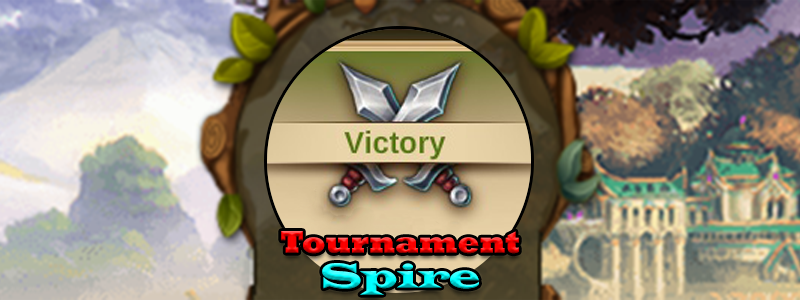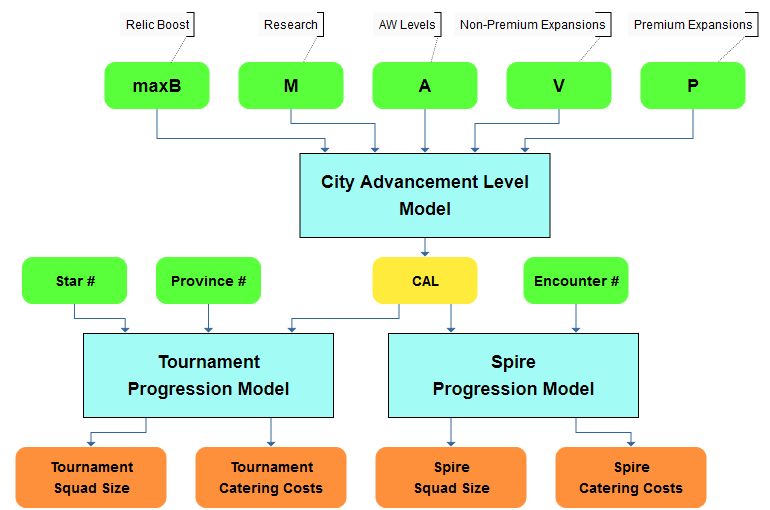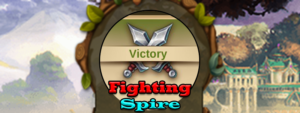In this post I am going to outline how Tournament and Spire of Eternity requirements calculation works after changes that were introduced in 2020. Both game elements feature fighting and catering options, and squad sizes for fighting and negotiation/catering costs increase as your city evolves and you do more encounters. So this is an umbrella post for several models that are (or will be) used for calculating these requirements.
Table of Contents
* – * – *
Summer 2020 brought us some major changes to the tournament structure. I won’t be focusing here on listing all the changes, but suffice to say that tournament calculations are completely different now from what we used to have for several years before that. In fact, if we peek under the hood, we will see that there is a significant overlap between new tournament calculations and the current Spire calculations. And while most of the completely different stuff will be related to the tournaments, Spire calculation are also impacted by this new development – albeit to a much smaller degree.
Modeling Overview
There are quite a few moving parts involved in the modeling, both on input and the output side. So a picture may save me a thousand words 😉
It looks complicated, but it really is not that bad. If you’ve seen previous posts on Spire and Tournament modeling, you already know what’s going on here. Probably 😉 The only new item here is City Advancement Level (CAL), but as you will see it is not exactly new.
Inputs
So green boxes in the diagram above are observable model inputs. Those who read Spire Squad Size Model v5.0 will recognize these, but here I will list them again:
- maxB – maximum unlocked boost percentage for T1/T2/T3 goods
- M – total number of unlocked mandatory tech items (research)
- A – total number of AW levels (including currently upgrading)
- V – number of placed non-premium expansions (including initial 6)
- P – number of placed premium expansions
The other ones (star # and province # for tournaments and encounter # for the Spire) are fairly self-explanatory. You’ve seen those in the respective progression models before.
Outputs
The orange boxes in the diagram are observable model outputs, so the parameters that we actually want to figure out.
CAL
Which leaves us with CAL. Previously, we would pin Spire and new tournament progression to their respective own base squad sizes. Well, CAL is basically a generalization of that idea. Base squad size was always effectively a representation of the city evolution, and had very little to do with fighting per se. And now we know that both Spire and new tournaments use the same calculation to figure out this city advancement level, and pin all other progressions to that single number. But actual base squad sizes are obviously different for Spire and the tournaments.
If it is somewhat confusing now, it’s OK, you’ll see how it all works together 😉
So in the separate posts we will describe all 3 models in the diagram above.
City Advancement Level Model
CAL, or City Advancement Level Model takes different parameters that developers consider relevant for city development (e.g. relics boost, research, AW levels and expansions) and bakes all of them into a single CAL number. This number represents city advancement level (duh!) the way the game sees it. I.e. if you have a higher CAL number, your squad sizes and catering costs for the same encounters will be higher in both Spire and the tournaments. Literally all size/amount parameters in the Spire and tournaments for any particular encounter are determined by this single number.
Tournament Progression Model
For a particular province number and stage (1*-6*) in the tournaments, enemy squad size always has the same ratio to your own squad size. And similar to that, your own squad size progression is also fixed. So all squad sizes in later provinces are completely determined by your own squad size at the very first 1* province encounter – which in turn is completely determined by CAL. And the same again goes for catering costs. The tournament progression model connects it all together.
Spire Progression Model
For a particular encounter in the Spire, enemy squad size always has the same ratio to your own squad size – just like in the tournaments. And similar to that, your own squad size progression when you ascend the Spire is also fixed. So all squad sizes in later encounters are completely determined by your own squad size at the very first Spire encounter – which in turn is completely determined by CAL. And the same again goes for negotiation/catering costs. The Spire progression model connects it all together.
Full Tournament and Spire Requirements Calculator
And here is a spreadsheet calculator that combines all these models. It uses fundamental parameters (research, provinces, AW levels, relics boost) to calculate CAL, and based on that it can calculate all progression outputs (squad sizes, catering costs) for new tournaments and the Spire. You can see it here:
- Full Tournament and Spire Requirements Calculator v2020.09.29 (Google Sheets)
You will need to clone it, then populate data on CALCalc sheet. Then your full tournament progression data will be on TournamentCalc sheet, and your full Spire progression data will be on SpireCalc sheet. Let me know if that works for you.
Expected Accuracy
Unlike the previous modeling of Spire SS (CAL predecessor), I don’t intend to make it super accurate. The reason I wanted to do that for Spire SS is to make sure that the functional form of the calculation is correct. But this also meant that I had to do a lot of data cleanup. I mean, A LOT. Now, when we are reasonably certain that functional form is correct (assuming it is the same), there is no reason to shoot for sub-1 accuracy. Errors of several points for base squad sizes are perfectly fine for all practical purposes, and it allows for much faster model updates. As long as there are no systematic drifts (indicating potential changes to functional form) this would work just fine.
And that’s pretty much it 😉



![Read more about the article Elvenar Woodelves – Day 22 [65%]](https://minmaxgame.com/wp-content/uploads/2019/03/WoodelvesFeaturedD22-300x113.png)
![Read more about the article Elvenar Sorcerers & Dragons – Day 26 [77%]](https://minmaxgame.com/wp-content/uploads/2019/04/SDFeaturedD26-300x113.png)
![Read more about the article Elvenar Woodelves – Day 28 [82%]](https://minmaxgame.com/wp-content/uploads/2019/03/WoodelvesFeaturedD28-300x113.png)

![Read more about the article Elvenar Woodelves – Day 25 [77%]](https://minmaxgame.com/wp-content/uploads/2019/03/WoodelvesFeaturedD25-300x113.png)

If a player would use the teleportspell and move houses, workshops and armories to the summonings before the tournament, would this make any difference concerning how many enemies the player would meet?
As none of these impact the calculation, then no, it will have no impact whatsoever.
That´s what I thougt and told my fellows. They are in desperation to find some loop hole for this new expensive tournament . Thank you 🙂
What should be entered in column T + U?
Is T = my troop size from the barracks?
where does the value in column U come from
If you’re referring to SSSo and TSSo, then these are your own initial squad sizes in the Spire and tournaments, respectively. These are not input parameters into calculations, these are there to calculate differences with the model forecast (e.g. modeling error).
Thank you for this.
Cell AA4 instructs to populate white cells, which T2:U2 are, hence the confusion I think. I had the same question before reading the reply.
How did you arrive on the reference data and coefficients? Are these calculated/estimated or taken from the game files?
Thank you!
levelling the martial monastery increases your troops health by 0.75%. how much does squad size go up if you level up your MM?
All information is in the post, so you can calculate this for your city. There is no single number for that.
For tournament catering, there are 7 potential catering requirements from which 3 are required. Is there any pattern to know in each tournament which three of those are demanded?
Not enough data yet, but from what I’ve seen nothing obvious stands out. It’s quite feasible that these are picked uniformly randomly.
Thank you!!1
Hi. Something I don’t understand. I took a screenshot for province 40. The troop ratio was 2.113. Before the new tournament started, I added 1 wonder level and one optional squad size from the previous chapter. The troop ratio went down to 2.083.
During the second tour of the tournament, I added one optional squad size. I was expected to get a lower troop ratio, but instead the new ratio increased to 2.093, which doesn’t make sense to me. Unless there is something I’ve missed in the articles. Can anyone provide an explanation ? Thx a lot
Optional squad sizes have absolutely no impact on the new tournament, and enemy troop ratios are fixed, so are not impacted by research or AW levels. So what you’re comparing is apples and oranges – your first troop ratio is from province 40 round 4, second one is from province 40 round 1 and the last one is from province 40 round 2. These are fixed ratios, you can see them in my calculator.
Thanks a lot for your answer.
My understanding was that only the enemy size was determined by the CAL, not our army size. I should definitely have a close look to your
So squad sizes are only useful to get more troops from military wonders in tournament/spire? Am I correct?
I read again all the explanations and tested your calculator. yes you made it clear that CAL was determining both enemenysize and ours. thank you for the explanations and your great work.
Regular squad sizes still work the same on the province map, i.e. they will also make your fights easier there. If you fight on the map, that is. This is really not an important consideration in the end game.
It was my understanding that our squad size and the enemy size were no longer correlated
I know this is a bit much to ask but as someone who hasn’t had to use excel in at least 2 decades.
Do you have or know of an open source calculator that you can input the info into(or even what “1* province 1” is)?
Also, do you have any info on the site that says what each tourney has for troops and what they require goods wise?
All calculators linked on this site are using Google Sheets, so that’s free if not open source (I think). 1* province is, well, a tournament province in the first round, or 1 star round. If you’ve ever seen tournament UI you know exactly what that means. The goods requirements are random, but requirements progression on provinces is fixed, and you can see it in the calculator. There are differences in troop compositions in different tournament types, there was a post somewhere on Beta forums with a chart.